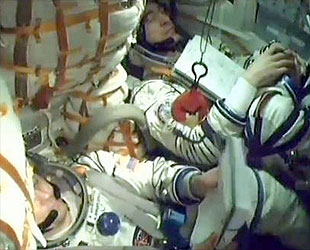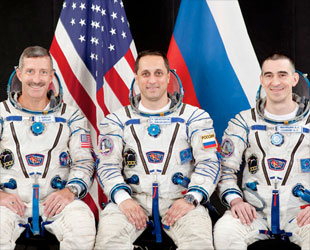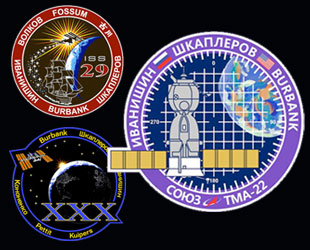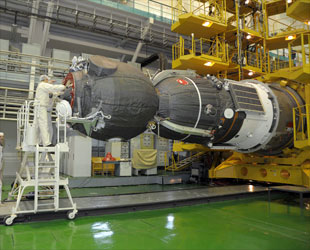November 13, 2011 – Two Russian cosmonauts, a NASA astronaut and an "Angry Bird" took off for the International Space Station Sunday evening (Nov. 13), soaring through falling snow and setting several historical firsts and lasts in the process.
The Russian Soyuz TMA-22 spacecraft lifted off on top a Soyuz-U booster from the Baikonur Cosmodrome in the desert steppe of Kazakhstan at 10:14 p.m. CST (11:14 a.m. local time, 0414 GMT Monday, Nov. 14). On board were Roscosmos Soyuz commander Anton Shkaplerov, flight engineer Anatoly Ivanishin and NASA astronaut Dan Burbank.
Flying with them was a toy red bird from the mobile video game "Angry Birds." Selected by Shkaplerov's 5-year-old daughter, the doll was used by the crew as a "zero gravity indicator" — when it began to float inside the Soyuz, the stuffed bird signaled to the crew they had reached orbit.

A stuffed doll of a red bird from the mobile game "Angry Birds" hangs inside Soyuz TMA-22 as a "zero-g indicator." (NASA TV) |
The trio (and their bird) will join Expedition 29 crewmates commander Michael Fossum and flight engineers Satoshi Furukawa and Sergei Volkov when their spacecraft docks to the station's Poisk mini-research module at 11:33 p.m. Tuesday, Nov. 15 (0533 GMT Wednesday, Nov. 16).
Their time as part of the Expedition 29 crew however, will be limited to less than a week due to the delays launching Soyuz TMA-22, which was originally scheduled to liftoff in September.
Returns to flight
The launch of Soyuz TMA-22 marked a return to flight for both manned Russian launches and separately, American astronauts flying to space.

Soyuz TMA-22 crew members, from left to right: Dan Burbank, Anton Shkaplerov, and Anatoly Ivanishin. (NASA/Roscosmos) |
Burbank is the first NASA astronaut to launch to orbit and the International Space Station (ISS) since space shuttle Atlantis landed on July 21, ending NASA's 30-year shuttle program. Though Americans have been launching aboard Soyuz for more than a decade, the U.S. manned space program is now having to solely rely on the Russian craft for access to orbit until such time domestic commercial craft are ready to fly in the next several years.
Burbank will be on the station when, as now planned, the first U.S. commercial cargo vehicle arrives at the outpost in January. SpaceX's Dragon capsule is among four craft under development that NASA hopes to lease to bring its astronauts to the ISS.
Burbank's and his crewmates' ride to orbit was threatened by the loss of a similarly-configured Soyuz-U rocket that suffered an engine failure in August. The Russian booster was lofting an unmanned Progress resupply craft instead of the crewed Soyuz, but Russian engineers needed to identify and correct for the problem before manned flights could resume.
The problem was ultimately traced to a blocked fuel line. Russia safely launched another Progress craft to the ISS last month, clearing the way for Soyuz TMA-22 to fly.

Soyuz TMA-22 crew emblem (right) shown with the Expedition 29 and Expedition 30 crew insignia. (NASA/Roscosmos) |
The launch delay however, forced NASA and its partners to prepare to temporarily evacuate the ISS just in case Soyuz TMA-22 could not launch before mid-November. It also limited Shkaplerov's, Ivanishin's and Burbank's time on-orbit.
The two cosmonauts and astronaut had originally trained to join the Expedition 29 crew for several weeks. Instead, they will be on board the outpost for just five days when they will take over as the Expedition 30 crew. Three new crew members will join them in December.
The Soyuz TMA-22 crew will return to Earth in March.
Last of its type
Soyuz TMA-22's launch also began the last flight of the TMA-class spacecraft. Since last year, Russia has been phasing in use of "digital" Soyuz TMA-M-class capsules, which have been upgraded to feature modern navigation and control systems.

Soyuz TMA-22, the last of the TMA-class spacecraft, seen being readied for launch at the Baikonur Cosmodrome. (RSC Energia) |
Soyuz TMA-03M is scheduled to lift off on Dec. 21, 2011, with Expedition 30 crewmembers Oleg Kononenko, André Kuipers and Don Pettit.
The first of the TMA vehicles launched to the International Space Station nine years ago in 2002. Like the TMA-M, the TMA superseded an earlier version of the Soyuz, the TM-class, used since 1986.
Soyuz TMA-22 is the 111th Soyuz spacecraft to fly since the very first Soyuz (simply "Soyuz 1") on April 23, 1967. Almost all of the crewed Soyuz lifted off from the same pad, referred to as "Gagarin's Start," after the world's first human in space, Yuri Gagarin, who departed Earth from the same pad 50 years ago.
